Testing for Seizures
What causes seizures?
Seizures occur for three main reasons:
1. Problems arising outside the central nervous system (the central nervous system [CNS] includes the brain and spinal cord) such as:
- Metabolic diseases caused by disorders of the liver or kidney.
- Very low blood sugar levels (hypoglycemia).
- Very low levels of calcium (hypocalcemia).
- Toxins, trauma, and systemic infections.
2. Problems directly involving the CNS including:
- Tumors, inflammation, and infections of the CNS (e.g., viral, bacterial, fungal, parasitic).
- Congenital defects (present at birth) or malformations within the CNS.
3. Primary Epilepsy.
- Seizures due to primary epilepsy have no identifiable cause and are called idiopathic meaning of unknown cause. Approximately 25-30% of dogs with seizures are diagnosed as having primary or idiopathic epilepsy.
How do we determine the cause of a pet’s seizures?
Finding the cause of a pet’s seizures can be difficult and usually starts with a complete history and physical examination. A pet’s history of illness includes details such as the number and duration of the seizures, the appearance of the seizures and whether something seems to trigger them. For example, an underweight, slow-growing puppy that has seizures after eating may have a congenital liver problem called a portosystemic shunt (abnormal liver vessels that prevent the liver from functioning normally). A mother dog nursing a large litter of puppies may have seizures because she is hypocalcemic (has low calcium levels) due to all the milk she is giving her puppies. Dogs and cats who roam freely outdoors are more likely to be exposed to toxins that might cause seizures.
A thorough physical examination involves checking over the entire pet, listening to the heart and lungs with a stethoscope, and palpating the abdomen (gently squeezing or prodding the abdomen with the fingertips to feel the internal organs).
The physical examination may provide clues about the cause of the seizure (e.g., signs like an abdominal mass or irregular heartbeat).
Although history and physical examination are essential, further investigation is usually needed. Your veterinarian will likely recommend screening tests to look for metabolic disease and other illnesses that can cause seizures. Screening tests are a series of simple tests that provide information about the overall health of the pet. The most common screening tests are: complete blood count (CBC), serum biochemistry, and urinalysis.
What might these screening tests indicate?
(a) Complete blood count (CBC) is a simple blood test that provides information about the different cell types in blood. These include red blood cells, which carry oxygen to the tissues, white blood cells, which fight infection and respond to inflammation, and platelets, which help the blood to clot. The CBC provides details about the number, size, and shape of the various cell types, and identifies the presence of abnormal cells in circulation.
A few examples of abnormalities on a CBC that might explain seizures: a high white blood cell count could indicate inflammatory or infectious conditions of the CNS; a very low platelet count might suggest bleeding into the brain, which could cause seizures. Abnormal white blood cells in the blood could signal underlying cancer.
(b) Serum biochemistry refers to the chemical analysis of serum (the liquid part of blood). There are many substances in serum, including proteins, enzymes, fats, sugars, hormones, electrolytes, etc. Analyzing these various substances gives us information about the health of the body’s organs and tissues such as the liver, kidney, and pancreas; it also helps in detecting diabetes and other metabolic diseases.
There are many abnormalities that might be found on serum biochemistry that could explain seizures in a pet. Some examples are:
- Abnormally high levels of the liver-related enzymes [alanine aminotransferase (ALT), alkaline phosphatase (ALP), and gamma glutamyltransferase (GGT)] could signal liver disease.
- Low levels of glucose (blood sugar), urea, and albumin (protein) in a puppy may suggest a congenital portosystemic shunt.
- Low levels of either glucose or calcium could cause seizures.
- Abnormally high levels of the kidney-related factors urea and creatinine suggest kidney disease, which can contribute to seizures.
- Abnormal electrolytes could signal underlying Addison’s disease (hypoadrenocorticism), which is a disorder of the adrenal gland.
(c) Urinalysis evaluates the chemical and physical properties of urine. A urinalysis is important in any sick animal, and is necessary for the proper interpretation of the biochemistry profile, especially in a pet that might have seizures due to kidney disease, diabetes, or other metabolic disorders.
What other tests might be done to find the cause of seizures in a pet?
There are many additional tests that can be done depending on the results of history, physical examination, and screening tests. Some examples of advanced testing include:
- Serum bile acid testing to look for liver disease or portosystemic shunt.
- Testing for infectious disease such as feline leukemia virus, feline immunodeficiency virus, toxoplasmosis, fungal infection, canine distemper.
- Testing for toxins if there is a history of a pet having eaten something unusual.
- Electrocardiogram, chest X-rays, heart ultrasound, or ProBNP blood test to diagnose heart disease.
- Testing to confirm Addison's disease.
If a cause for the seizures still cannot be identified, then it is possible the seizures originate within the brain itself, and further neurologic testing might be advised. This could include:
- Collection and analysis of cerebrospinal fluid (CSF) to look for inflammation, infection, or cancer. CSF is the fluid that surrounds the brain and spinal cord. Changes in the appearance and composition of this fluid may help to pinpoint the cause of seizures.
- Specialized imaging studies such as computed tomography (CT scan) and magnetic resonance imaging (MRI) to look for tumors or congenital malformations of the CNS.






